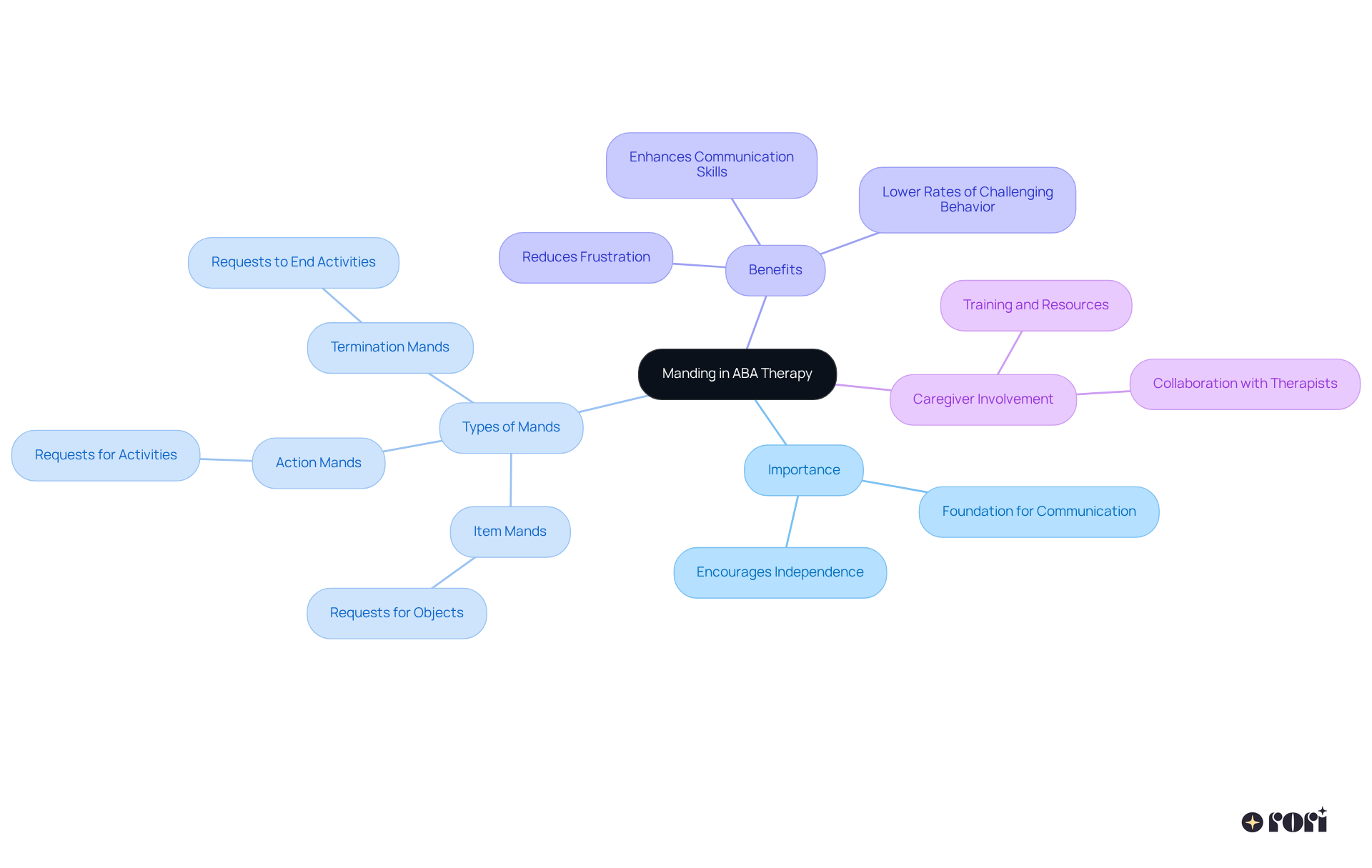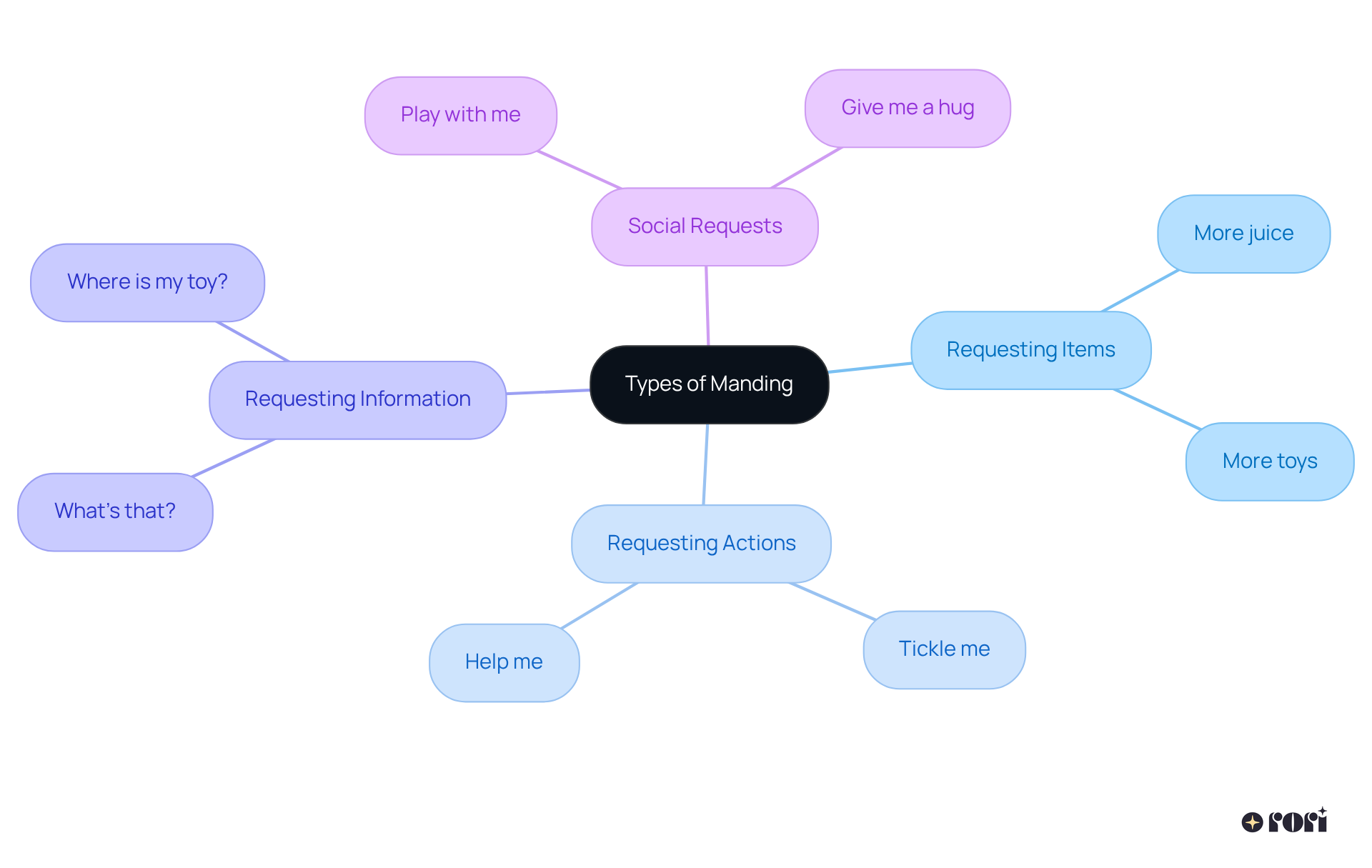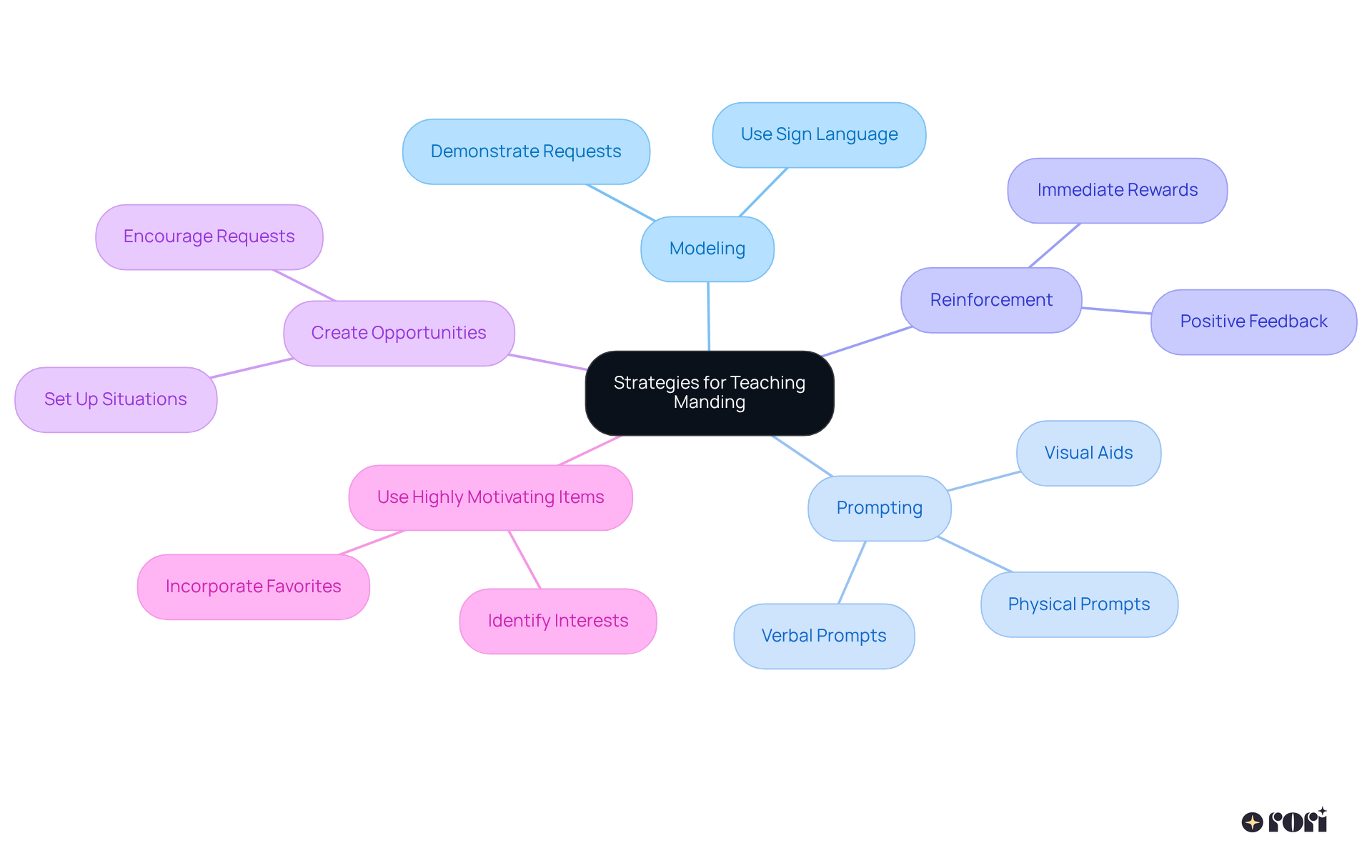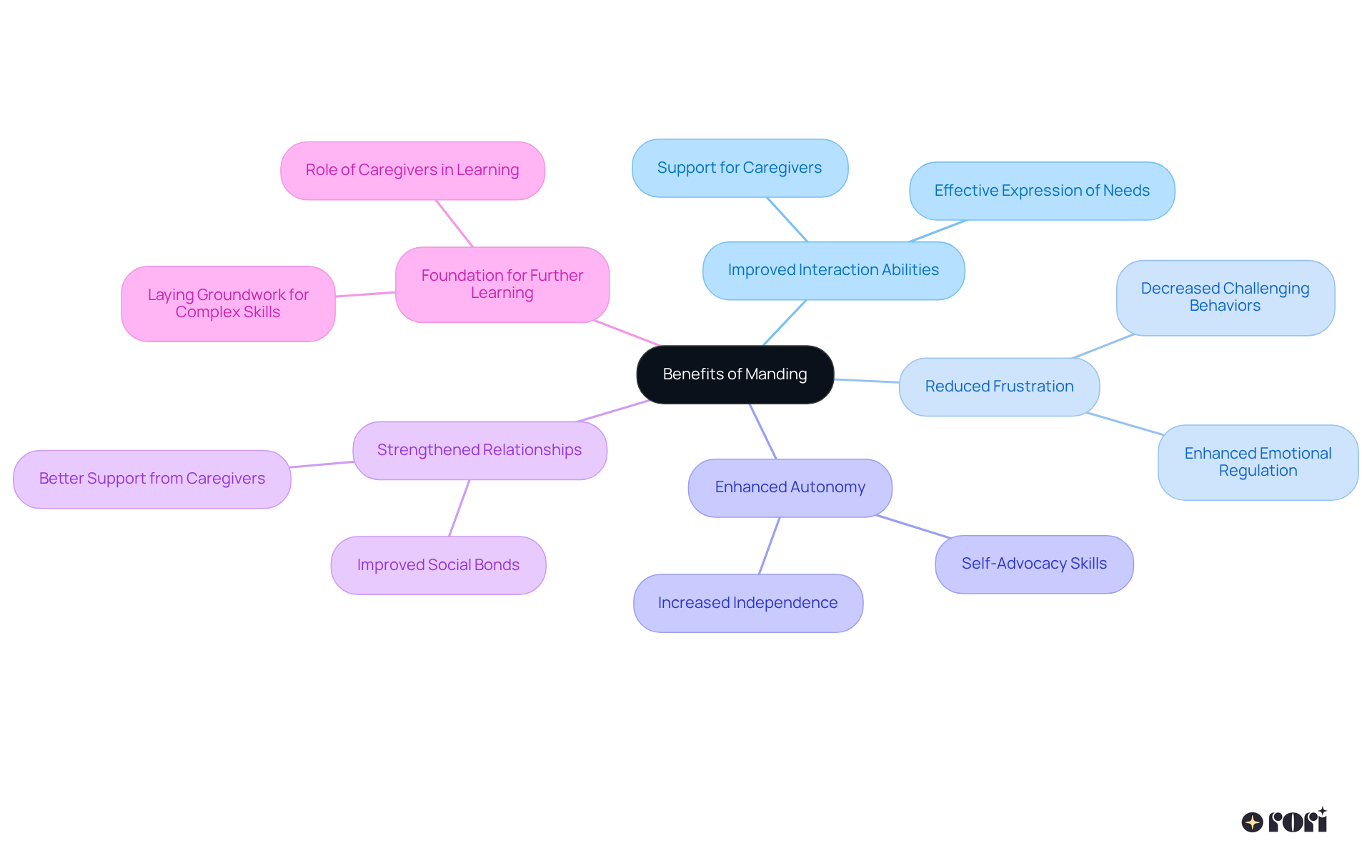This article dives into some wonderful strategies for enhancing communication skills through ABA manding. You might be wondering, what is manding? It's all about teaching individuals to make requests effectively! Mastering manding can do so much more than just improve children’s ability to express their needs. It can also:
How amazing is that? This, in turn, supports overall development and social interaction. Let’s explore this together!
Understanding how individuals express their needs is so important in the world of Applied Behavior Analysis (ABA) therapy, especially when we talk about manding. This vital way of communicating not only helps children share their desires but also boosts their independence and cuts down on frustration. As caregivers and therapists team up to put effective manding strategies into action, a key question comes to mind: how can we tailor these techniques to really enhance communication skills and improve overall behavioral outcomes?
Exploring the ins and outs of manding shows us not just its significance, but also the incredible difference it can make in the lives of children with autism and their families. Let’s dive in together!
The concept of aba manding is essential in Applied Behavior Analysis (ABA) therapy. It’s all about how individuals make requests for things they need—like saying 'I want juice' or 'Help me.' This way of communicating is super important because it helps people express their wishes clearly, reducing frustration and encouraging independence. Think about it: when a child feels thirsty, their desire for a drink motivates them to ask for it. This not only boosts their interpersonal skills but also strengthens their ability to communicate meaningfully.
There are different types of mands, including:
Each serving a unique purpose in communication. Research shows that kids who can make requests often show less challenging behavior. This highlights how beneficial these requests can be for their overall behavior and communication skills. By teaching aba manding, therapists assist children in building a strong foundation for further language development, which can enhance their social interactions and overall quality of life.
It’s also crucial for parents to be involved in this process. When guardians learn about ABA principles and strategies, they can better support their child’s progress. This teamwork between caregivers and therapists creates a consistent approach to behavioral support, making interventions more effective. For example, in a case study on 'Modeling and Teaching Mands,' therapists demonstrated the desired language during activities with kids. This hands-on approach helps children learn to imitate and eventually use mands on their own.
This collaboration not only empowers caregivers but also leads to better behavioral outcomes for children. So, let’s explore this together! We’re here to help you every step of the way!

In aba manding therapy, you’ll notice various forms of requesting, each playing a unique role in enhancing interaction skills. Let’s take a closer look at these:
Requesting Items: This is all about asking for tangible things, like toys or snacks. For instance, a little one might express a desire for more juice by saying, 'More juice.'
Requesting Actions: Here, children ask someone to do something, such as 'Tickle me' or 'Help me.'
Requesting Information: Kids often seek answers, posing questions like 'What’s that?' or 'Where is my toy?'
Social Requests: These requests are centered on social interactions, with examples like 'Play with me' or 'Give me a hug.'
Understanding these types of requests helps caregivers create opportunities for children to practice aba manding in various settings, significantly boosting their communication skills. Research shows that effective requests can lead to improved social interactions and a reduction in challenging behaviors, enabling children to express their needs and desires more effectively. Let’s explore this journey together!

To effectively teach manding, let’s explore some friendly strategies together:
Modeling: Show the desired mand in context. For instance, if a little one wants a toy, demonstrate how to ask for it, either verbally or through sign language.
Prompting: Use different prompting techniques that fit the young person's needs. This could be verbal prompts, visual aids, or even physical prompts to help them express their wants.
Reinforcement: Quickly strengthen successful requests by providing what they asked for. This positive reinforcement is so important! It motivates the young one to keep using requests as a way to communicate.
Create Opportunities: Set up situations where they need to request something they want. For example, placing a favorite toy just out of reach can encourage them to ask for it.
Use Highly Motivating Items: Make sure the items or actions they’re requesting are really motivating. Research shows that effective mand training depends on knowing what excites each child, which can significantly boost their chances of making successful requests.
By consistently applying these strategies, you can create an environment that encourages effective communication through aba manding. This approach not only enhances social engagement and reduces frustration for children with autism but also incorporates aba manding to empower parents with the understanding and skills needed to help their kids achieve their behavioral goals. Remember, active participation and aligning with therapeutic strategies lead to better behavioral outcomes, making education for supporters a crucial part of the ABA therapy journey. We’re here to help you every step of the way!

Aba manding provides a variety of important advantages for young individuals with autism, while also strengthening guardians through education and assistance. Let’s dive into some of these benefits!
Improved Interaction Abilities: Learning aba manding helps youngsters express their needs and desires more effectively. This leads to better overall interaction! It’s not just about the child; it also equips guardians with the knowledge to support their little ones in expressing themselves.
Reduced frustration is achieved when youngsters can communicate their needs through aba manding, significantly decreasing their frustration levels. This reduction can lead to fewer challenging behaviors. Studies show that kids who articulate their needs are less likely to exhibit these behaviors, highlighting how crucial communication is for emotional regulation. Caregivers who understand this can make informed choices that positively impact their child’s growth.
Enhanced autonomy through aba manding empowers youngsters to advocate for themselves. This nurtures a sense of independence and self-advocacy, which is vital for their development. Plus, it boosts the guardian's confidence in supporting their child's growth!
Strengthened relationships: Improved interaction skills through aba manding enhance exchanges with peers and caregivers, leading to deeper social bonds. Caregivers who actively engage in this process can better support their child’s social development.
Foundation for Further Learning: Mastering the art of requesting, or aba manding, lays the groundwork for more complex communication skills. This facilitates future language development and opens up learning opportunities. By understanding the principles of ABA and the importance of requesting, caregivers can play a vital role in their child’s learning journey.
Recognizing these advantages emphasizes the essential role of requesting in aba manding therapy, ultimately aiding the individual’s growth and development. Did you know that the overall prevalence of autism spectrum disorder (ASD) is 27.6 per 1,000 youths aged 8 years? This highlights the need for effective interaction strategies, including aba manding. Incorporating parent-led ABA solutions can further enhance these outcomes, allowing parents to actively participate in their child’s communication development.
Let’s explore this together and see how we can make a difference!

Mastering ABA manding is such an important step in boosting communication skills for individuals, especially children with autism. By grasping and applying effective manding strategies, caregivers and therapists can truly enhance how children express their needs and desires. This not only helps reduce frustration but also nurtures independence, paving the way for better social interactions and emotional regulation.
In this article, we’ve highlighted some key points, including:
The role of parental involvement and the teamwork between caregivers and therapists are crucial, showing how this collaboration can lead to more effective outcomes. Plus, the many benefits of manding—like improved interaction abilities, less frustration, and greater autonomy—really showcase its vital role in the developmental journey of children with autism.
So, let’s not underestimate the significance of mastering ABA manding! By actively engaging in this process, caregivers can empower their children, creating a nurturing environment that encourages effective communication. Learning manding is more than just acquiring skills; it’s about building connections, enhancing relationships, and opening doors for future learning opportunities. Embracing these strategies can profoundly impact the lives of children and their families, highlighting just how essential communication is for personal growth and development. Let’s explore this together!
What is manding in ABA therapy?
Manding in ABA therapy refers to how individuals make requests for things they need, such as asking for help or expressing a desire for a specific item. It is a crucial aspect of communication that helps people express their needs clearly.
Why is manding important?
Manding is important because it reduces frustration, encourages independence, and enhances interpersonal skills. It allows individuals, especially children, to communicate their wishes effectively, which can lead to better overall behavior and social interactions.
What are the different types of mands?
The different types of mands include item mands, action mands, and termination mands. Each type serves a unique purpose in communication.
How does teaching manding affect children's behavior?
Research shows that children who can make requests through manding often display less challenging behavior, indicating that these communication skills positively influence their overall behavior and social skills.
How can parents support their child's manding development?
Parents can support their child's manding development by learning about ABA principles and strategies, which enables them to effectively assist in their child's progress. Collaboration between caregivers and therapists creates a consistent approach to behavioral support.
What role do therapists play in teaching manding?
Therapists play a crucial role in teaching manding by demonstrating desired language during activities and encouraging children to imitate and use mands independently. This hands-on approach helps children learn and develop their communication skills.
What are the benefits of collaboration between caregivers and therapists?
Collaboration between caregivers and therapists empowers parents and leads to better behavioral outcomes for children. It ensures a consistent approach to interventions, making them more effective in supporting the child's development.